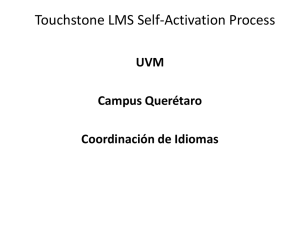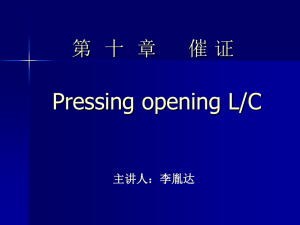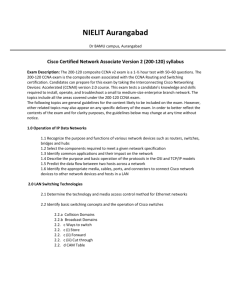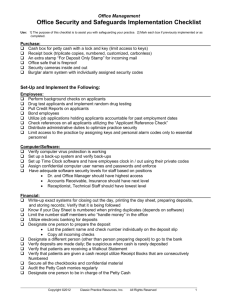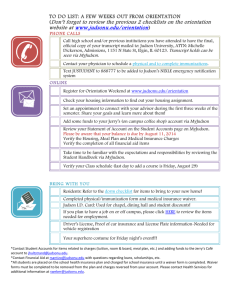switches bridges
advertisement
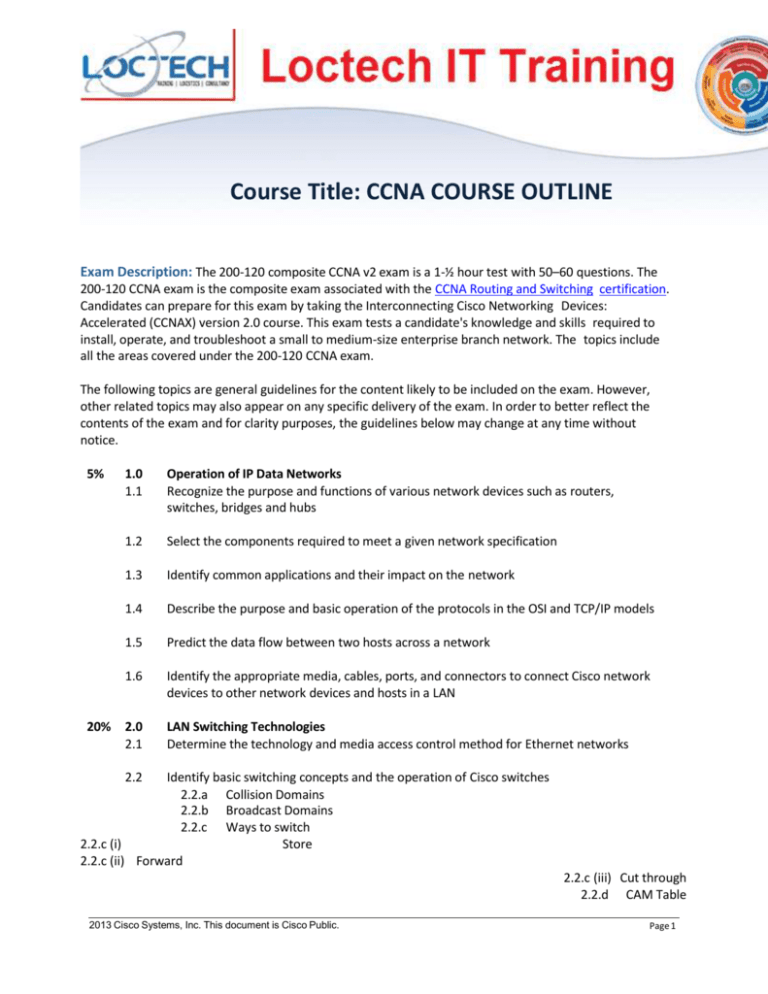
Course Title: CCNA COURSE OUTLINE Exam Description: The 200-120 composite CCNA v2 exam is a 1-½ hour test with 50–60 questions. The 200-120 CCNA exam is the composite exam associated with the CCNA Routing and Switching certification. Candidates can prepare for this exam by taking the Interconnecting Cisco Networking Devices: Accelerated (CCNAX) version 2.0 course. This exam tests a candidate's knowledge and skills required to install, operate, and troubleshoot a small to medium-size enterprise branch network. The topics include all the areas covered under the 200-120 CCNA exam. The following topics are general guidelines for the content likely to be included on the exam. However, other related topics may also appear on any specific delivery of the exam. In order to better reflect the contents of the exam and for clarity purposes, the guidelines below may change at any time without notice. 5% 20% 1.0 1.1 Operation of IP Data Networks Recognize the purpose and functions of various network devices such as routers, switches, bridges and hubs 1.2 Select the components required to meet a given network specification 1.3 Identify common applications and their impact on the network 1.4 Describe the purpose and basic operation of the protocols in the OSI and TCP/IP models 1.5 Predict the data flow between two hosts across a network 1.6 Identify the appropriate media, cables, ports, and connectors to connect Cisco network devices to other network devices and hosts in a LAN 2.0 2.1 LAN Switching Technologies Determine the technology and media access control method for Ethernet networks 2.2 Identify basic switching concepts and the operation of Cisco switches 2.2.a Collision Domains 2.2.b Broadcast Domains 2.2.c Ways to switch 2.2.c (i) Store 2.2.c (ii) Forward 2.2.c (iii) Cut through 2.2.d CAM Table 2013 Cisco Systems, Inc. This document is Cisco Public. Page 1 5% 3.4.a 2.3 Configure and verify initial switch configuration including remote access management 2.3.a hostname 2.3.b mgmt ip address 2.3.c ip default-gateway 2.3.d local user and password 2.3.e enable secret password 2.3.f console and VTY logins 2.3.g exec-timeout 2.3.h service password encryption 2.3.i copy run start 2.4 Verify network status and switch operation using basic utilities such as 2.4.a ping 2.4.b telnet 2.4.c SSH 2.5 Describe how VLANs create logically separate networks and the need for routing between them 2.5.a Explain network segmentation and basic traffic management concepts 2.6 Configure and verify VLANs 2.7 Configure and verify trunking on Cisco switches 2.7.a dtp (topic) 2.7.b auto-negotiation 2.8 Identify enhanced switching technologies 2.8.a RSTP 2.8.b PVSTP 2.8.c Etherchannels 2.9 Configure and verify PVSTP operation 2.9.a Describe root bridge election 2.9.b Spanning tree mode 3.0 3.1 IP Addressing (IPv4/IPv6) Describe the operation and necessity of using private and public IP addresses for IPv4 addressing 3.2 Identify the appropriate IPv6 addressing scheme to satisfy addressing requirements in a LAN/WAN environment 3.3 Identify the appropriate IPv4 addressing scheme using VLSM and summarization to satisfy addressing requirements in a LAN/WAN environment 3.4 Describe the technological requirements for running IPv6 in conjunction with IPv4 dual stack 2013 Cisco Systems, Inc. This document is Cisco Public. Page 2 20% 3.5 Describe IPv6 addresses 3.5.a global unicast 3.5.b multicast 3.5.c link local 3.5.d unique local 3.5.e eui 64 3.5.f auto-configuration 4.0 4.1 IP Routing Technologies Describe basic routing concepts 4.1.a packet forwarding 4.1.b router lookup process 4.1.c Process Switching/Fast Switching/CEF 4.2 Configure and verify utilizing the CLI to set basic Router configuration 4.2.a hostname 4.2.b local user and password 4.2.c enable secret password 4.2.d console & VTY logins 4.2.e exec-timeout 4.2.f service password encryption 4.2.g interface IP Address 4.2.g (i) loopback 4.2.h banner 4.2.i motd 4.2.j copy run start 4.3 Configure and verify operation status of a device interface 4.3.a Serial 4.3.b Ethernet 4.4 Verify router configuration and network connectivity using 4.4.a ping 4.4.a (i) extended 4.4.b traceroute 4.4.c telnet 4.4.d SSH 4.4.e sh cdp neighbors 4.5 Configure and verify routing configuration for a static or default route given specific routing requirements 4.6 Differentiate methods of routing and routing protocols 4.6.a Static vs. dynamic 4.6.b Link state vs. distance vector 4.6.c next hop 4.6.d ip routing table 4.6.e Passive Interfaces (how they work) 2013 Cisco Systems, Inc. This document is Cisco Public. Page 3 4.6.f 4.6.g 4.6.h Admin distance split horizon metric 4.7 Configure and verify OSPF 4.7.a Benefit of single area 4.7.b Configure OSPv2 4.7.c Configure OSPv3 4.7.d Router ID 4.7.e Passive Interface 4.7.f Discuss multi-area OSPF 4.7.g Understand LSA types and purpose 4.8 Configure and verify interVLAN routing (Router on a stick) 4.8.a sub interfaces 4.8.b upstream routing 4.8.c encapsulation 4.9 Configure SVI interfaces 4.10 Manage Cisco IOS Files 4.10.a Boot Preferences 4.10.b Cisco IOS Images (15) 4.10.c Licensing 4.10.c (i) Show license 4.10.c (ii) Change license 4.11 Configure and verify EIGRP (single AS) 4.11.a Feasible Distance/Feasible Successors/Administrative distance 4.11.b Feasibility condition 4.11.c Metric composition 4.11.d Router ID 4.11.e Auto summary 4.11.f Path Selection 4.11.g Load Balancing 4.11.g (i) Unequal 4.11.g (ii) Equal 10% 5.0 5.1 5.2 IP Services Configure and verify DHCP (IOS Router) 5.1.a Configuring router interfaces to use DHCP 5.1.b DHCP options (Basic overview and functionality) 5.1.c Excluded addresses 5.1.d Lease time Describe the types, features, and applications of ACLs 5.2.a standard (editing and sequence numbers) 5.2.b extended 2013 Cisco Systems, Inc. This document is Cisco Public. Page 4 5.2.c 5.2.d 5.2.e 10% named numbered Log option 5.3 Configure and verify ACLs in a network environment 5.3.a named 5.3.b numbered 5.3.c Log option 5.4 Identify the basic operation of NAT 5.4.a purpose 5.4.b pool 5.4.c static 5.4.d 1 to 1 5.4.e overloading 5.4.f source addressing 5.4.g one way NAT 5.5 Configure and verify NAT for given network requirements 5.6 Configure and verify NTP as a client 5.7 Recognize High availability (FHRP) 5.7.a VRRP 5.7.b HSRP 5.7.c GLBP 5.8 Configure and verify syslog 5.8.a Utilize syslog output 5.9 Describe SNMP v2 and v3. 6.0 6.1 Network Device Security Configure and verify network device security features 6.1.a Device password security 6.1.b Enable secret vs. enable 6.1.c Transport 6.1.c.1 disable telnet 6.1.c.2 SSH 6.1.d VTYs 6.1.e physical security 6.1.f service password 6.1.g Describe external authentication methods 6.2 Configure and verify Switch Port Security 6.2.a Sticky MAC 6.2.b MAC address limitation 6.2.c static/dynamic 2013 Cisco Systems, Inc. This document is Cisco Public. Page 5 6.2.d 6.2.d (i) 6.2.d (ii) shutdown violation modes err disable 6.2.d (iii) protect restrict 6.2.e Shutdown unused ports 6.2.f err disable recovery 6.2.g Assign unused ports in unused VLANs 6.2.h Putting Native VLAN to other than VLAN 1 20% 6.3 Configure and verify ACLs to filter network traffic 6.4 Configure and verify ACLs to limit telnet and SSH access to the router 7.0 7.1 Troubleshooting Troubleshoot and correct common problems associated with IP addressing and host configurations 7.2 Troubleshoot and resolve VLAN problems 7.2.a Identify that VLANs are configured 7.2.b Verify port membership correct 7.2.c Correct IP address configured 7.3 Troubleshoot and resolve trunking problems on Cisco switches 7.3.a Verify correct trunk states 7.3.b Verify correct encapsulation configured 7.3.c Correct VLANs allowed 7.4 Troubleshoot and resolve ACL issues 7.4.a Verify statistics 7.4.b Verify permitted networks 7.4.c Verify direction Interface 7.5 Troubleshoot and resolve Layer 1 problems 7.5.a Framing 7.5.b CRC 7.5.c Runts 7.5.d Giants 7.5.e Dropped packets 7.5.f Late collisions 7.5.g Input/output errors 7.6 Identify and correct common network problems 7.7 Troubleshoot and resolve spanning tree operation issues 7.7.a Verify root switch 7.7.b Verify priority 7.7.c Verify mode is correct 7.4.c (i) 2013 Cisco Systems, Inc. This document is Cisco Public. Page 6 7.7.d 10% Verify port states 7.8 Troubleshoot and resolve routing issues 7.8.a Verify routing is enabled (sh ip protocols) 7.8.b Verify routing table is correct 7.8.c Verify correct path selection 7.9 Troubleshoot and resolve OSPF problems 7.9.a Verify neighbor adjacencies 7.9.b Verify hello and dead timers 7.9.c Verify OSPF area 7.9.d Verify interface MTU 7.9.e Verify network types 7.9.f Verify neighbor states 7.9.g Review OSPF topology table 7.10 Troubleshoot and resolve EIGRP problems 7.10.a Verify neighbor adjacencies 7.10.b Verify AS number 7.10.c Verify load balancing 7.10.d Split horizon 7.11 Troubleshoot and resolve interVLAN routing problems 7.11.a Verify connectivity 7.11.b Verify encapsulation 7.11.c Verify subnet 7.11.d Verify native VLAN 7.11.e Port mode trunk status 7.12 Troubleshoot and resolve WAN implementation issues 7.12.a Serial interfaces 7.12.b Frame relay 7.12.c PPP 7.13 Monitor NetFlow statistics 7.14 TS EtherChannel problems 8.0 8.1 WAN Technologies Identify different WAN Technologies 8.1.a Metro ethernet 8.1.b VSAT 8.1.c Cellular 3g/4g 8.1.d MPLS 8.1.e T1/E1 8.1.f ISDN 8.1.g DSL 8.1.h Frame relay 2013 Cisco Systems, Inc. This document is Cisco Public. Page 7 8.1.i 8.1.j Cable VPN 8.2 Configure and verify a basic WAN serial connection 8.3 Configure and verify a PPP connection between Cisco routers 8.4 Configure and verify frame relay on Cisco routers 8.5 Implement and troubleshoot PPPoE Contact Info: 234-8150579950 234-8150579951 234-8150579952 Website: www.lochtechng.com Email: lawson.chubueze@lochtechng.com john.ikheloa@lochtechng.com info@lochtechng.com Application Form 1. Name: 2. Designation: 3. Name of Organization/ Company: 4. Address for communication: 5. Highest academic qualifications: 6. Phone: (O) (R) 7. Mobile: 8. E-mail: 9. Course Name: ________________________________________________________________________ 10. Class Type: (Week-Day or Week-End): ___________________________________________________ Signature of Applicant: Date: Sponsoring Company Authority: Contact Info: 234-8150579950 234-8150579951 234-8150579952 Website: www.lochtechng.com Email: lawson.chubueze@lochtechng.com john.ikheloa@lochtechng.com info@lochtechng.com
